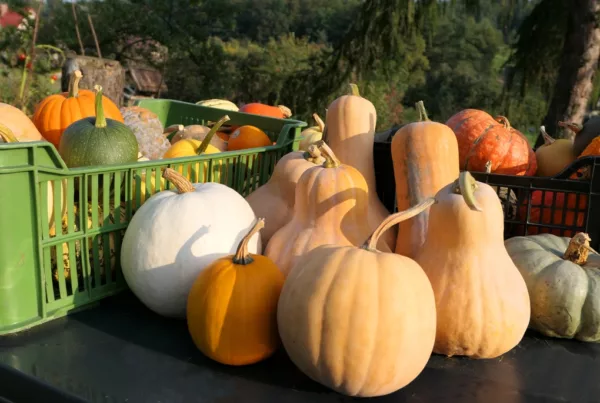Written by Kristina Hicks-Hamblin
 You’ve made the wise decision to use foot by foot spacing to grow your carrot crop – but you might be wondering just how many seeds to sow per square!
You’ve made the wise decision to use foot by foot spacing to grow your carrot crop – but you might be wondering just how many seeds to sow per square!
You’ll learn the ideal number shortly, but first you might enjoy discovering just how this spacing was developed. This way you can confidently sow your homegrown produce, knowing that the techniques you use are tried and tested.
Where Does Square Foot Plant Spacing Come From?
Maybe you’ve heard of this growing technique on social media or in gardening forums, without even knowing that someone actually invented the method!
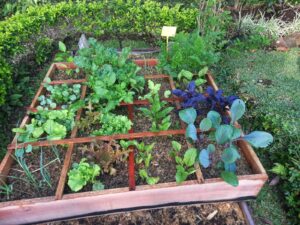
A productive raised garden bed, grown “on the grid.”
This plant spacing was developed by Mel Bartholomew, the creator of the food growing technique known as Square Foot Gardening. Mel came up with this method after recognizing the waste of space, time, energy, and resources that is involved in row-based gardening.
Mel started with the recommended spacing for row-based agriculture, but played around with growing more densely until he hit on a brilliant idea: growing food in a four-by-four-foot raised bed divided by a grid into sixteen equal sections. Each section measures twelve inches by twelve inches.
In his decades of research and experimenting, Mel figured out the best number of plants to grow per grid section for all the common backyard garden crops – including carrots!
So, How Many Carrots Per Square Foot?
In this gardening method, carrots are sown at a rate of sixteen plants per twelve-by-twelve-inch square – that’s to say, sixteen per individual grid section, with each planted three inches apart from each other.
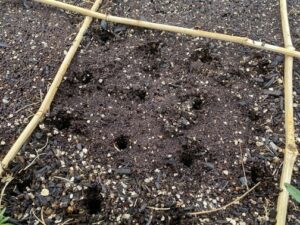
This root crop is sown sixteen per section. Photo by Kristina Hicks-Hamblin.
This spacing meets several conditions that will provide you with a healthy and abundant harvest of root crops from the garden.
First, this arrangement maximizes the use of your raised bed “real estate.” But it also provides plants with plenty of elbow room, so they aren’t cramped and don’t become misshapen. (Wonky shaped roots are loads of fun to take photos of – the problem is, once you put down your phone and move on to the kitchen, they’re not so easy to peel and chop!)
This 16-per-square spacing also ensures that there is plenty of air flow around each individual plant. Good air flow helps reduce the risk of fungal and bacterial diseases which have an easier time gaining a foothold in crowded, humid conditions. We want to make things harder for pests and diseases, not easier!
Additional Tips for Planting Carrots
Before you get busy with the fun task of sowing lovely little carrot seeds in the soil, here are a few more tips that will be helpful:
-
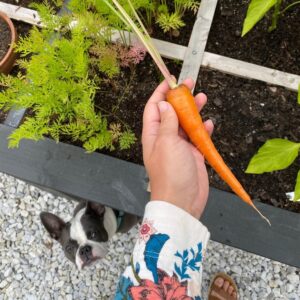
Following a few tips will result in a bountiful harvest.
Poke 16 holes in a section, making them approximately 1/4 of an inch deep. Drop in the seeds, then fill in the holes with Mel’s Mix. This will ensure that the seeds are only lightly covered, since they require some sunlight for germination.
- Since carrot seeds aren’t the most reliable germinators, sow two or three seeds together for each of the sixteen holes in the grid section.
- Keep seeds moist while they germinate and until they reach a few inches tall. You may need to water daily unless your area is prone to rain. Once the plants are established, they will be somewhat more resistant to dry conditions as they grow and you can transition to normal watering.
- For fall crops, sow seeds ten to twelve weeks before your average first frost. For spring sowings, plant seeds two to four weeks before your last average frost. This schedule will allow these cool weather veggies the right amount of time to grow and mature.
- Did you notice all the previous tips recommended sowing seeds rather than transplanting small plants? Take that as a cue – carrots that are grown from seed will be healthier, more successful, and more uniform than those that are transplanted.
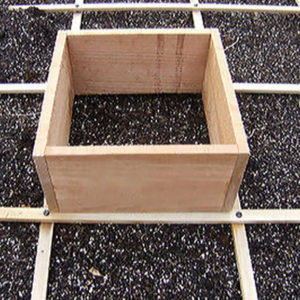
A top hat can be filled with Mel’s Mix and used for longer varieties of root crops.
In the Square Foot Gardening Method, the recommended depth for most raised beds is six inches. While that is deep enough for some carrot varieties like ‘Chantenay Red Core,’ ‘Ox Heart,’ or ‘Little Fingers,’ longer varieties need more depth.
In the SFG Method this need is resolved by adding a “top hat,” a twelve-by-twelve-inch box, that is added as a second level to one of the sections of your raised bed, and is filled with Mel’s Mix, this Method’s growing medium of choice.
Now that you know exactly how to sow your carrot seeds, why not increase your gardening know-how by discovering the original way of “growing on the grid?”



